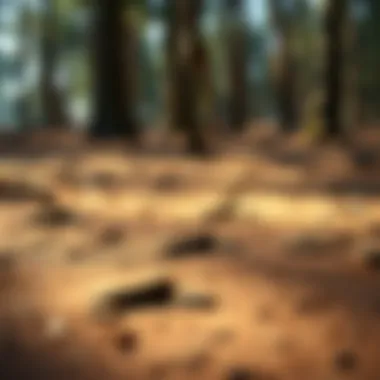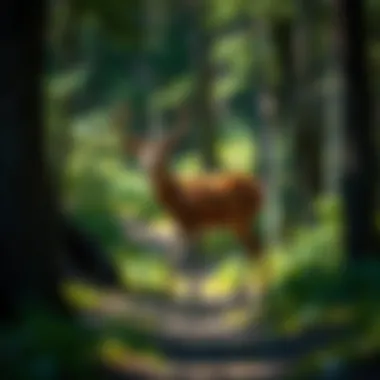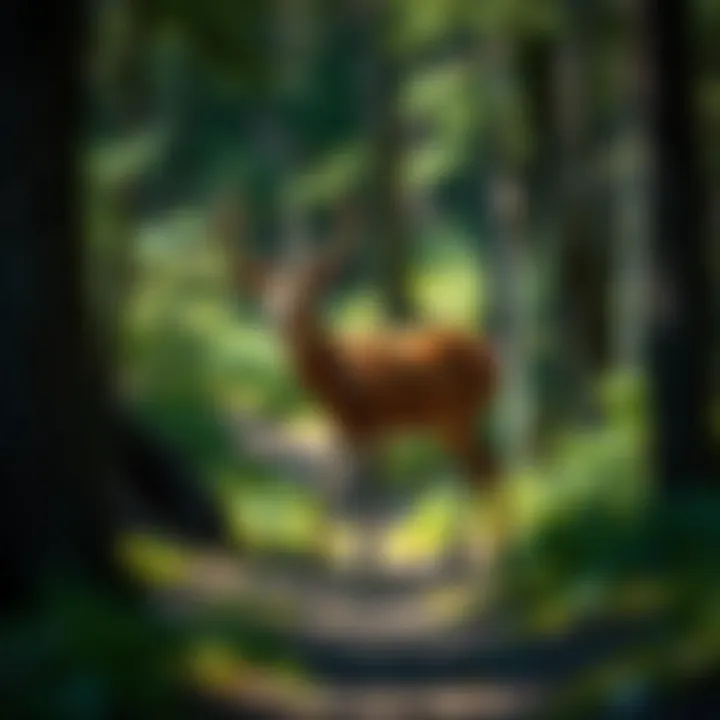Deer Run at Canyon Trails: Ecological Insights


Intro
In the vastness of our forested landscapes, the intricate ballet of life unfolds daily. One of the most captivating actors in this ecosystem is the deer. These graceful creatures navigate the canyon trails with a blend of instinct and adaptability, leaving an indelible mark on their surroundings. Understanding the dynamics of their movements is not merely an academic pursuit but a concerted effort towards preserving the health of these woodlands.
Deer are not just passive residents; they play a crucial role in shaping the vegetation and consequently the entire ecosystem. This article aims to peel back the layers on how deer interact with their environment, especially in canyon trails. We will delve into the ecological significance of these interactions, the pressing need for sustainable practices, and the ways communities can engage in stewardship of their local forests.
By examining these elements, we provide valuable insights that contribute to the conversation on forest ecology and biodiversity.
Forest Ecology and Biodiversity
Importance of Forest Ecosystems
Forests are the heart of the planet, often described as lungs of the earth. They provide essential services, including carbon sequestration, water filtration, and soil stabilization. These ecosystems host a myriad of species, both flora and fauna, which rely on them for survival. When we talk about deer in canyon trails, we refer to a crucial piece of this ecological puzzle. If deer populations grow unchecked, they can lead to overgrazing, threatening the very fabric of these habitats.
Flora and Fauna in Woodlands
In woodlands, the interdependence of species speaks volumes.
- Deer: Known herbivores, they consume a wide range of vegetation, influencing plant community dynamics.
- Vegetation: Diverse plant species provide cover, food, and habitat for countless other birds and mammals.
Beyond immediate interactions, there are cascading effects. For instance, the browsing behavior of deer can suppress certain plant species, allowing others to thrive. This selective feeding can shape the overall biodiversity of the area, which can be beneficial or detrimental depending on ecological balance. The intricate web of forest life depends on these dynamics; if one thread frays, the entire structure is affected.
Sustainable Forestry Practices
Techniques for Responsible Management
Sustainability within forestry is not a buzzword; it's a necessity. Effective management techniques can make a world of difference.
- Selective Logging: Ensures that mature trees are harvested while younger ones can grow.
- Forest Thinning: Reduces competition among trees, promoting healthier growth.
Practices like these help maintain habitats for deer while also supporting biodiversity. When implemented thoughtfully, these methods afford forests the resilience they need to adapt to changing environmental conditions.
Certification Schemes and Standards
Various certification programs exist to ensure responsible forestry. Organizations like the Forest Stewardship Council (FSC) set standards that align economic needs with ecological sustainability. These schemes encourage practices that protect wildlife habitats, including those essential for deer, thus ensuring a balance between human activity and natural integrity. More details can be found on FSC's official site.
Community Engagement and Stewardship
Role of Local Communities
Local communities hold remarkable power in conservation efforts. Their knowledge of the land can be invaluable. This can take many forms:
- Community-Based Projects: Involving locals in reforestation initiatives not only empowers residents but also fosters a sense of ownership over their environment.
- Education Programs: Teaching about the ecological roles of deer can inspire a new generation of stewards.
Engaging with local populations ensures that sustainable practices are not just imposed from the outside but are organically integrated into the community's culture.
Volunteer Opportunities for Engagement
Many organizations offer volunteer opportunities to engage the community directly with nature:
- Trail Restoration Projects: Participants can help maintain and improve the trails used by deer and other wildlife.
- Wildlife Monitoring Programs: Volunteers can assist in tracking deer populations and their behaviors, gathering essential data that aids in conservation strategies.
Through these efforts, individuals contribute to a broader understanding of how to manage and protect forest ecosystems effectively. By getting involved, they ensure not just the survival of deer but the rich biodiversity ideal for thriving woodlands.
"Where the deer roam, the forest flourishes. Conservation is intertwined with community, and only together can we ensure a vibrant ecosystem for future generations."
As we analyze the majestic deer roaming the canyon trails, we gain insights that stretch far beyond these beautiful creatures. We gain an understanding of the need for concerted action to protect and preserve our natural world.
Prelude to Deer Behavior in Forest Ecosystems
Understanding deer behavior in forest ecosystems is essential. Deer, as significant herbivores, play a crucial role in maintaining the ecological balance within these habitats. They contribute to forest health, influence plant community structures, and serve as prey for predators, thereby sustaining the food web. This article aims to explore the dynamic interplay between deer and their forest habitat, highlighting how their behaviors impact ecosystem functions.
Understanding Deer Movement Patterns
The movement patterns of deer in forested areas can be as varied as the terrain itself. Knowing how and why deer traverse certain paths is important for forest management and conservation efforts. Deer are not just roaming in search of food; their movements are influenced by a variety of factors, including seasonal changes, availability of resources, and even social interactions with other deer. For instance, during the fall, many herds may migrate to lower elevations in search for warmer weather and more abundant food.
To get deeper insight, consider the following elements that contribute to their movement patterns:
- Topography: As deer navigate through hilly terrains and valleys, their routes can be winding and complex, significantly affecting their foraging efficiency.
- Predation Risk: Deer often shift their trails based on the presence of predators such as coyotes or mountain lions. They tend to choose paths that allow for quick escape, which often leads them through denser vegetation.
- Human Influence: Urbanization and recreational areas can also alter these natural patterns, leading to increased road crossings and ultimately affecting deer populations.
"Deer understand their environment like the back of their hoof, adapting to movement paths that feel safe and rewarding."
Significance of Canyon Trails
Canyon trails serve as more than just pathways for deer; they are lifelines within forest ecosystems. The unique geographic features of canyons create microhabitats that foster diverse plant and animal life. Water sources often populate these areas, allowing deer easier access to hydration without straying too far from cover, which is particularly crucial during hot summer months.
Additionally, the trails provide essential corridors for deer when traversing between feeding grounds. In terms of biodiversity, the vegetation along canyon trails offers shelter and nourishment. Key points of significance include:
- Access to Variety: The flora diversity encourages deer to have varied diets, which is important for their health and the ecosystem's health.
- Habitat Connectivity: The trails link habitat patches, providing opportunities for gene flow between deer populations—essential for genetic diversity.
- Behavioral Observation: Understanding deer movements along canyon trails allows researchers and biologists to make informed decisions regarding conservation strategies and hunting regulations.


Through examining these intricate behaviors and habitats, we gain a clearer picture of how deer influence their environments and why preserving these trails is crucial for ensuring the balance of forest ecosystems.
Canyon Trails: A Unique Habitat
Canyon trails form a crucial part of the ecosystem, serving not only as pathways for deer but also as dynamic habitats integrating various ecological components. Their distinct features often create localized environments where different wildlife, particularly deer, flourish.
Geographic Features Influencing Deer Run
The topography of canyon trails holds a significant role in how deer navigate their surroundings, making it essential to understand these geographic influences.
Elevation Changes
Elevation changes in canyon trails create areas of varying difficulty and opportunity for deer. Deer are naturally inclined to traverse slopes and ridges because these geographical alterations promote the growth of diverse plant life, which they depend on for food. The elevation gradient presents a key characteristic that affects temperature and humidity levels, thus influencing vegetation patterns that are beneficial for deer habitats. The challenges posed by steep inclines can also act as natural barriers to potential predators, granting deer a more secure environment to graze and raise their young. However, these elevated regions require certain adaptations; thus, while elevation changes offer advantages, they can also lead to increased energy expenditure for deer moving between different altitudes.
Soil Composition
Soil composition is another vital player in the canyon trails' ecosystem, greatly affecting the types and health of vegetation present. Different soils can lead to varied nutrient levels, impacting the availability of food sources for deer. A key characteristic of these soils is their drainage capacity; well-drained soils promote deeper root systems, allowing for robust plant growth and higher biodiversity. Such diversity is essential, as it offers a wide range of forage for deer. However, areas with poor soil composition might result in sparse vegetation, limiting food options for the deer population. Therefore, understanding soil types is critical for both conservation efforts and ensuring that deer populations maintain a healthy balance with their environment.
Water Sources
Water sources found in canyon trails are invaluable, acting as sustenance not only for deer but for the entire ecosystem. The presence of springs, streams, or small ponds can directly shape deer movement patterns, as these natural resources attract them, ensuring hydration and encouraging frequent visits. The key characteristic is that these water sources often serve other wildlife species as well, creating a hub of activity that supports extensive biodiversity. However, the proximity of water to urban development presents potential challenges; increased human presence can lead to contamination or depletion of these vital resources. Thus, the management of water sources is paramount in preserving the integrity of the deer population and the broader ecosystem.
Vegetation Types in Canyon Trails
The richness of vegetation types along canyon trails contributes extensively to the health of deer populations. Varied flora not only aids in food diversity but also provides essential cover, contributing to the overall well-being of these animals.
Flora Diversity
Flora diversity is essential in enriching the ecosystem within canyon trails. More species mean more food types, which directly benefits deer. The variety offers ample foraging options while also attracting different types of insects and other animals, maintaining a balanced ecosystem. This diversity ensures resilience against disease and changing climate conditions. However, an overabundance of invasive species can disrupt this balance, making monitoring vegetation crucial for maintaining habitats conducive to deer health and well-being.
Food Sources for Deer
Food sources for deer along canyon trails are not just about nourishment; they include essential nutrients found in various plants and shrubs. High-quality green forages are particularly attractive during late spring and summer when deer require increased energy for growth and reproduction. A crucial characteristic here is the seasonal fluctuation of food availability, where some plants peak in nutrient richness during particular times of the year. This seasonal availability can create competition among deer populations, influencing movement patterns and social structures. Nevertheless, the migration towards richer food sources can also lead to overgrazing in specific areas, underscoring the need for sound management practices.
Seasonal Changes
The seasonal changes within canyon trails dictate the availability of resources for deer and profoundly influence their behavior. In springtime, lush greenery emerges, providing nourishment, while winter's harsh conditions can force deer to adapt their foraging strategies significantly. An important feature of these seasonal changes is the adaptation of deer to seek shelter and food during varying conditions. The transition periods can be especially crucial, as they require proper migration patterns to mitigate human-deer interactions caused by shifting habitats. Understanding these seasonal dynamics can support effective conservation practices that ensure deer populations remain healthy and sustainable.
Ecological Role of Deer in Forest Dynamics
The role of deer in forest dynamics cannot be overstated. Their interactions with the environment shape not only the composition of plant life but also influence the entire ecosystem's health and viability. Deer act as both grazers and seed dispersers, essentially playing a dual role that underpins the ecological balance in their respective habitats. Within the context of canyon trails, understanding this role is pivotal, as it highlights the intricate relationships between flora and fauna, fostering deeper insights into forest management and conservation practices.
Impact on Plant Life
Grazing Effects
Grazing by deer can have both positive and negative impacts on plant life within forest ecosystems. On one hand, it can control the overgrowth of certain plant species, allowing for a more balanced distribution of vegetation. This can promote the health of certain native species, which might otherwise become outcompeted. However, excessive grazing can lead to a decline in preferred plants, which may disrupt the natural food web. The resilience of these grazing effects makes them particularly interesting for studies focusing on ecological health.
In essence, deer are nature’s caretakers, keeping excess growth in check, but their nibbling can cause a peculiar paradox where certain species flourish while others wane. The challenge lies in finding that fine line between nourishment and overconsumption.
Seed Dispersion
Seed dispersion is another critical aspect of how deer contribute to the health of forest ecosystems. When deer consume fruits and berries, they unintentionally aid in the propagation of various plant species through their droppings. This natural process fosters genetic diversity and aids in the establishment of new plants in previously barren areas. As seeds move through their digestive tracts, they also experience a form of 'natural fertilizer', which enhances their ability to germinate and thrive.
Moreover, this unique feature of seed dispersion illustrates a symbiotic relationship where both deer and plants benefit. For the deer, it means accessing nutritious fruits, while the plants enjoy a broader distribution of their seeds across the landscape. This dynamic encourages a rich tapestry of flora, sustaining various animal species in turn.
Biodiversity Support
Deer significantly support biodiversity within forest ecosystems. By feeding on certain plants, they inadvertently promote the growth of others, allowing a wider variety of species to flourish. This interaction promotes a healthier ecosystem, as it leads to diversified habitats that can support various forms of wildlife, including other herbivores, carnivores, and a multitude of insects.
The unique capability of deer to balance plant populations cultivates conditions ideal for a rich ecosystem, showcasing their role as facilitators rather than mere inhabitants. The ability of deer to sustain biodiversity highlights their crucial place within the food web, influencing ecological dynamics at both micro and macro levels.
Deer as a Keystone Species
Deer are often identified as a keystone species due to their significant impact on the ecosystem. A keystone species, by definition, is one whose presence or absence dramatically alters the structure of a community. In canyon ecosystems, deer regulate the populations of certain vegetation types, which in turn affects other species that depend on those plants for survival. In scenarios where deer populations fluctuate, the ripple effect can change the entire ecological landscape, affecting everything from soil health to other animal populations.
Through their grazing habits and seed dispersion activities, they effectively shape the environment, which further underscores their role as a critical component of forest dynamics. Understanding and acknowledging the importance of deer as a keystone species is vital in promoting effective conservation strategies that aim at preserving biodiversity and forest health in canyon ecosystems.
"The presence of deer not only alters vegetative composition but is also a linchpin for maintaining the ecological intricacies of forests, particularly in canyon trails where diverse species thrive due to their contributions."
Behavioral Patterns Observed in Deer
Understanding the behavior of deer, especially in forest ecosystems like the canyon trails, provides a lens to view their role in overall ecological dynamics. By examining how deer forage, move, and interact socially, we gain insights into their adaptive strategies that not only support their survival, but also shape the environment they inhabit.
Foraging Strategies
Deer are selective feeders, and their foraging strategies are a prime component of their behavioral patterns. These strategies often vary by the season; for instance, in spring, deer tend to seek out tender shoots and lush greens, while in winter, they may rely more on woody browse as foliage becomes scarce. The choice of food greatly impacts vegetation dynamics within their habitat.
Deer generally exhibit a few notable foraging behaviors:


- Bite-and-Switch: This involves shifting quickly between different food sources, optimizing nutrient intake while avoiding overgrazing on any single plant.
- Patterned Grazing: In certain areas, particularly those heavily trafficked by deer, one can notice substantial grazing patterns, showing their preference for specific plant species, often leading to a sort of natural land management through selective feeding.
Understanding these patterns can lead to more effective forest management practices, enriching ecological diversity and health.
Social Structures within Deer Herds
Deer herds are more than just a collection of individuals; they are structured societies with complex social interactions. The dynamics within these groups can be critical for their survival and influence their behavior in various ecological contexts. Two elements stand out when considering the social structure of deer: hierarchy dynamics and the roles of males and females.
Hierarchy Dynamics
Hierarchy within deer herds establishes dominance and influence among members, impacting group decisions such as movement and foraging.
- Key Characteristic: The most dominant deer usually gain priority access to food and mates. This prioritization is essential for maintaining genetic health, as superior traits are more likely to be passed on, boosting the entire population's resilience.
- Unique Feature: The hierarchy is often fluid, subject to change based on factors like age, health, and environmental pressures. Such adaptability is beneficial, allowing herds to respond effectively to challenges posed by predation or competition for resources.
Understanding these dynamics illuminates how deer interact with their surroundings and will help in crafting targeted conservation strategies that take into consideration the importance of social structure in maintaining healthy populations.
Role of Males and Females
In deer society, the roles of males and females are distinctly marked, each contributing to the herd's survival strategy.
- Key Characteristic: Males typically engage in more aggressive behaviors during mating seasons, demonstrating dominance and can often be seen in displays of strength, such as antler clashes. This behavior forms a critical aspect of mate selection and overall herd genetics.
- Unique Feature: Females usually form the core of the social structure, often initiating the movement to foraging sites and leading the young, thus playing a nurturing role that influences juvenile learning and social cohesion.
Recognizing these roles and their implications on herd behavior is crucial for understanding deer ecology as a whole. This awareness can guide conservation efforts by promoting strategies that foster healthy interactions within deer populations, ensuring a balance between various herd dynamics.
By exploring these behavioral patterns, webuild a comprehensive picture of deer within their forest ecosystems, highlighting their interrelatedness with the flora and other fauna, ultimately underscoring the intricate web of life that characterizes these environments.
The Influence of Human Activity
The interaction between human activity and wildlife populations cannot be overstated, particularly when analyzing deer in the context of canyon trails. As urbanization and recreational activities increase in proximity to natural habitats, understanding this influence becomes crucial for effective conservation and ecological balance. Many species, including deer, are directly affected by human-induced changes, which can alter their behavior, habitats, and overall survival.
Urban Development Impact
Urban development poses a significant threat to deer populations, often resulting in habitat loss and fragmentation. The expansion of residential areas, roads, and commercial sites disrupts the continuity of their natural range, leading to a decline in food resources and safe movement corridors. In highly urbanized areas, deer populations may face increased mortality rates due to vehicle collisions, as deer often attempt to cross roads that bisect their habitats unexpectedly.
Furthermore, urbanization modifies the ecosystem, introducing artificial barriers and pollutants. This subject deserves nuanced analysis, as developmental practices can either mitigate or exacerbate habitat disturbance. Emphasizing green spaces within urban plans, for instance, can support wildlife corridors that facilitate safe deer movement. Also, sustainable development that incorporates nature conservation strategies can considerably enhance forested areas adjoining urban spaces.
Recreational Activities and Deer
Hiking Trails
Hiking trails can significantly contribute to the ecological dynamics of deer populations. Organized trails can reduce the random disturbances caused by off-trail activities, enabling deer to maintain their behavior patterns with minimal stress. Notably, trails often become arteries for wildlife movement. A well-placed trail can lead to enhanced opportunities for observation and study, allowing ecologists and casual enthusiasts alike to learn more about deer behavior in their natural setting.
Nevertheless, trails often invite human traffic, which might disrupt deer feeding and breeding grounds. Ensuring that trails are designed with proper guidelines minimizes these impacts. Educating hikers about remaining on-path can help eliminate the wandering into sensitive areas. In short, hiking trails can foster a healthier coexistence when equipped with thoughtful management.
Wildlife Observation
Wildlife observation allows enthusiasts and researchers to closely monitor deer without causing disruption to their natural behaviors. Not only does it provide valuable data for studies in ecology, but it also cultivates a passion for wildlife conservation among observers. Establishing designated observation areas can draw visitors into areas where deer often roam, thus reducing disturbances in their habitat while increasing human appreciation for these animals.
However, there are disadvantages. Excessive human presence can deter deer or lead to their habituation, causing them to become overly reliant on human food sources. This behavioral shift can result in populations that are estranged from their natural instincts, diminishing their ability to forage appropriately during lean seasons.
Hunting Considerations
Hunting, when managed properly, can serve as a form of population control for deer, helping to balance numbers in overpopulated regions. Responsible hunting practices can eliminate weak or unhealthy individuals, thus enhancing the overall health of the deer population while sustaining the ecosystem. Participating in regulated hunting seasons allows for maintaining a healthy agricultural environment and reducing instances of disease transmission among wildlife.
However, hunting poses conflicts as well. Inaccessible areas for deer can be too heavily trafficked by hunters, leading to habitat degradation. Hunter education plays an essential role in mitigating such issues, promoting ethical hunting practices and emphasizing conservation.
"Responsible human intervention can vastly improve the ecological stability of deer populations, balancing needs for both conservation and recreation."
Conservation Practices and Strategies
Conservation practices play a pivotal role in sustaining deer populations and their habitats within the complex dynamics of forest ecosystems. In areas such as canyon trails, where deer find both food and shelter, it becomes essential to cultivate practices that not only protect these habitats but also enhance the overall ecological balance. Effective conservation strategies can lead to improvements in biodiversity, establishing a healthier environment both for deer and other species that coexist in these rich ecosystems.
Sustainable Forest Management
Sustainable forest management encompasses a range of practices designed to maintain the health and productivity of forest ecosystems while ensuring they can continue to support diverse wildlife populations. Key elements include:
- Selective Logging: Rather than clear-cutting, maintaining tree cover encourages regeneration and protects crucial habitats for deer and other wildlife.
- Maintaining Water Sources: Protecting natural water bodies and ensuring adequate water supply is vital for deer, especially in recreationally active areas where water availability may be compromised.
- Promoting Native Vegetation: The strategic planting of native flora not only provides food sources for deer but also helps sustain insect populations and other wildlife, creating a thriving ecosystem.
Such practices help tailor the forest management approach to the ecological needs of the area, ensuring long-term health which benefits deer and other species alike. Notably, sustainable practices can also mitigate the effects of climate change, fostering resilience in these environments.
Community Involvement in Deer Conservation
Engaging local communities in deer conservation efforts further strengthens the resilience of forest ecosystems. When local stakeholders recognize the value of these practices, the outcome is often more positive. Consider the following:
- Educational Programs: Local schools and community organizations can implement programs designed to educate individuals about deer behavior and the importance of sustainable practices.
- Volunteer Programs: Communities can organize volunteer days for planting native trees or cleaning up trails, fostering a personal connection to the land.
- Incentives for Homeowners: Homeowners can be encouraged to create deer-friendly habitats in their backyards through incentives, such as tax breaks or grants for sustainable landscaping that promotes native species.
Involvement from the community not only shows commitment to conservation but builds a support network that promotes ongoing environmental stewardship. Communities can share knowledge, observations, and resources, creating a tapestry of effort that is hard to overlook.
"When communities care for their environment, the benefits multiply, enriching lifestyles while contributing significantly to conservation."


In summary, both sustainable forest management and community involvement are crucial for fostering an ecosystem where deer populations can thrive. By integrating these strategies, we can better navigate the complexities of ecological dynamics in forested areas, reassuring a future where wildlife and natural habitats flourish side by side.
Challenges Faced by Deer Populations
Understanding the challenges faced by deer populations is crucial for sustainable forest management and overall ecosystem health. These challenges can have cascading effects on plant communities, predator-prey dynamics, and ultimately the health of the forested ecosystems where deer thrive. In the context of Canyon Trails, addressing these issues helps maintain a balance between human interests and wildlife conservation.
Habitat Loss and Fragmentation
Habitat loss and fragmentation is one of the most pressing issues deer populations face today. As urban development sprawls into previously untouched areas, the natural habitats that deer rely upon are disappearing.
- Loss of grazing areas: As lands are cleared for residential or commercial use, deer lose critical feeding grounds. Reduced grazing areas lead directly to nutritional stress, which can affect their reproductive success and overall health.
- Increased edges: Fragmentation creates what ecologists refer to as "edge effects." The transition zones between different habitat types can alter the behavior and survival rates of deer. While some species thrive near edges, deer often prefer deeper woods, where they feel safer from predators.
- Barriers to movement: Roads and urban infrastructures serve as barriers, preventing deer from accessing ranges necessary for their survival. This not only limits their ability to find food but also disrupts their seasonal migrations, affecting breeding and feeding cycles.
Getting back to the essence of conservation, efforts such as wildlife corridors are essential in reconnecting fragmented habitats. These corridors can facilitate the movement of deer between separated areas, aiding in genetic diversity and overall population stability.
Predator Dynamics
Predator dynamics are another significant aspect of the challenges faced by deer. The presence and abundance of various predators influence deer behavior and population dynamics.
- Predator populations: In ecosystems where predator populations, such as coyotes and mountain lions, are managed or preserved, deer populations can experience pressure. This can lead to increased stress levels among deer, altering their grazing behavior and habitat use, as they become more vigilant around potential threats.
- Compensatory predation: Some studies suggest that when deer populations become overly abundant due to a lack of natural predators, it can trigger compensatory predation. This phenomenon occurs when an increase in prey population leads to a population boom in predators, which in turn starts to stabilize or even reduce deer populations.
- Behavioral adaptations: Deer often adapt to these pressures through changes in behavior. For example, during peak predator activity, deer may shift their feeding patterns to dusk and dawn, making them more vulnerable to human encounters or other risks, like vehicle collisions.
Efforts by conservationists to restore natural predator-prey balances can help address deer population issues, leading to healthier ecosystems overall. Understanding the nuances of these predator dynamics is essential for effective wildlife management and conservation efforts.
"A thriving population of deer is closely tied to their environment's integrity. Loss of habitat and predators can disrupt this balance, leading to unforeseen consequences."
Future Research Directions
Understanding the dynamics of deer populations within forest ecosystems is not just an academic pursuit but a necessary endeavor in light of escalating environmental challenges. As such, future research directions have the potential to refine our techniques and bolster our conservation efforts. In this section, we'll discuss two critical avenues of inquiry: emerging technologies in wildlife tracking and long-term ecological studies. These areas of focus promise to elevate our understanding, enhance conservation strategies, and ensure that deer populations thrive alongside forest ecosystems.
Emerging Technologies in Wildlife Tracking
The advancement of technological tools represents a groundbreaking shift in wildlife conservation strategies. Innovations such as GPS collars, remote camera traps, and drone surveillance are now commonplace. These technologies are reshaping the way researchers study deer behavior in canyon trails.
Some benefits of employing these technologies include:
- Precision Tracking: GPS collars allow for real-time location data, offering insights into deer movement patterns that were previously hidden.
- Reduced Human Disturbance: Non-intrusive monitoring methods, like camera traps, minimize stress on wildlife, capturing more natural behaviors.
- Data Analysis: The ability to collect large datasets provides researchers with detailed statistics about population dynamics, grooming habits, and responses to environmental changes.
However, there are considerations to keep in mind. Ensuring that such technologies are ethically deployed and maintaining data privacy for sensitive areas is crucial. Furthermore, training and funding for these advanced initiatives should be prioritized in ecological studies.
Long-term Ecological Studies
Conducting long-term ecological studies is vital for understanding the adaptive strategies of deer in relation to their environment. These studies go beyond short-term observations to reveal shifts over seasons and years. With the continuous changes in climate and habitat, the insights gleaned can steer conservation efforts and policy decisions.
Elements that make these studies invaluable include:
- Habitat Monitoring: Over time, scientists can document how deer adapt to habitat fluctuations, which can inform land management practices.
- Species Interactions: Long-term data sheds light on relationships with other wildlife and plant communities, uncovering the intricacies of the ecosystem.
- Climate Adaptation: By analyzing historical data, researchers can trace how deer populations respond to climatic changes, giving essential clues about their resilience.
The End: The Integral Role of Deer in Canyon Ecosystems
Understanding the pivotal role deer play in canyon ecosystems is essential for grasping the broader dynamics of these unique habitats. Deer are not merely components of these environments; they act as architects of ecological balance, shaping plant communities and influencing wildlife populations through their behaviors and feeding patterns.
Benefits of Deer to Ecosystem Health
Deer contribute to ecosystem health in various meaningful ways:
- Herbivory Regulation: By grazing on specific plant species, deer help maintain plant diversity, preventing certain species from becoming overly dominant. This balance is crucial because it allows a multitude of plants to thrive, which in turn supports diverse wildlife.
- Habitat Modification: Deer trails, often created through their consistent movement, provide pathways that other species may utilize. These paths can enhance soil moisture retention and allow new plant growth, fostering rich habitats for a range of organisms.
- Seed Dispersal: Deer are also responsible for the dispersal of seeds. When they consume fruits or seeds, they often travel great distances before excreting them, which facilitates plant propagation across the landscape. This natural service helps to maintain the biodiversity of the area.
Considerations in Conservation Practices
Recognizing the integral role of deer in canyon ecosystems signals the importance of conservation practices that focus on their well-being.
- Sustainable Management: It is critical to implement management strategies that consider deer populations in relation to vegetation and other wildlife. This may mean allowing for regulated hunting or creating safe corridors to minimize road crossings, ensuring deer populations remain healthy without negatively impacting surrounding ecosystems.
- Community Engagement: Local communities play a major role in deer conservation. Educating residents about the benefits of deer, while also outlining the potential challenges of overpopulation, is vital. This understanding can foster initiatives that promote cohabitation and respect for these animals.
"In every walk with nature, one receives far more than he seeks."
– John Muir
For deeper insights into deer populations and ecological dynamics, consider visiting resources like Wikipedia or National Park Service.
By fostering a deeper understanding of these relationships, stakeholders can help craft policies that preserve biodiversity and the natural beauty of our canyon ecosystems.
References and Further Reading
Understanding the intricate dynamics of deer populations in canyon trails is not just an academic exercise; it holds significant importance for anyone involved in forestry, ecology, or wildlife conservation. In this article, we have laid a foundation for comprehension, but further reading can deepen knowledge and provide valuable resources for practical application.
Importance of Continuous Learning
To effectively manage and conserve deer populations, a multi-faceted approach is essential. With the rapid changes in forest ecosystems due to human influence, climate change, and other factors, staying updated on the latest research is crucial. Exploring references and further reading sources equips professionals with the insights necessary for informed decision-making. Here are some key reasons:
- Informed Strategies: Effective conservation practice relies on evidence-based strategies. Engaging with the latest studies ensures that the approaches taken are scientifically sound and environmentally sustainable.
- Broader Context: The ecological dynamics at play within canyon trails intersect with many other fields, such as climate science, urban planning, and community outreach. Reference materials can expand perspectives on these interconnected issues.
- Networking Opportunities: Many papers and resources highlight ongoing research or present conferences where professionals can collaborate, share knowledge, and contribute to collective efforts.
Recommended Resources
- Scientific Journals: Publications like the Journal of Wildlife Management or Ecological Applications offer cutting-edge research on deer behavior, habitat use, and conservation strategies. Access to these journals can foster a greater understanding of emerging trends.
- Government Publications: Agencies such as the U.S. Forest Service or the National Park Service often publish resources that outline management practices and case studies in specific areas. Their websites are also filled with data and reports that can inform decisions at a local level.
- Professional Organizations: Joining organizations such as the The Wildlife Society or the Society for Conservation Biology can provide access to a wealth of information and a community of like-minded professionals who are eager to share their findings and experiences.
- Books and Field Guides: Comprehensive texts that focus on deer ecology or local flora can enhance understanding of the environment in which deer thrive. Look for guides that emphasize the relationships between species and their habitats.
"Knowledge is the beginning of action, but action is the end of knowledge."
It's beneficial to not only read but also apply that knowledge in practical settings. Engaging with experts, participating in workshops, and contributing to conservation efforts can bridge the gap between theory and practice.















